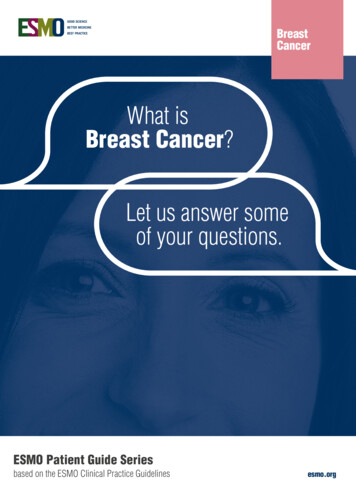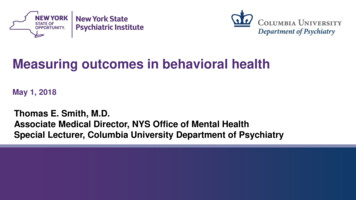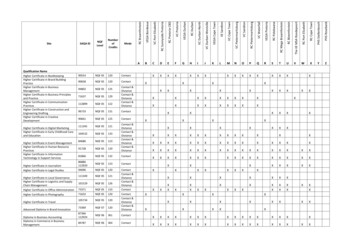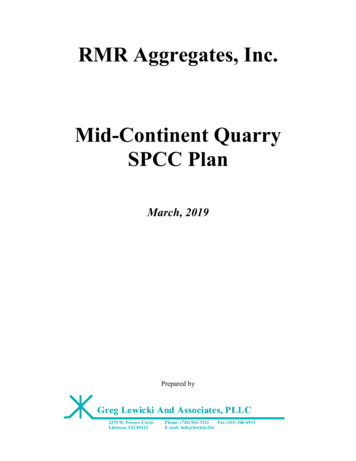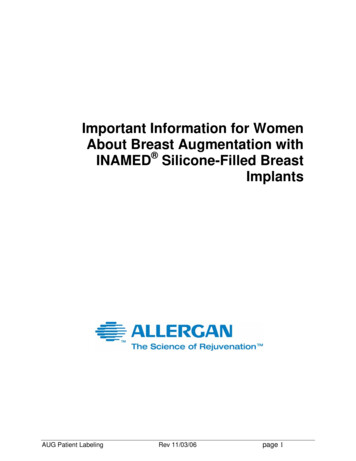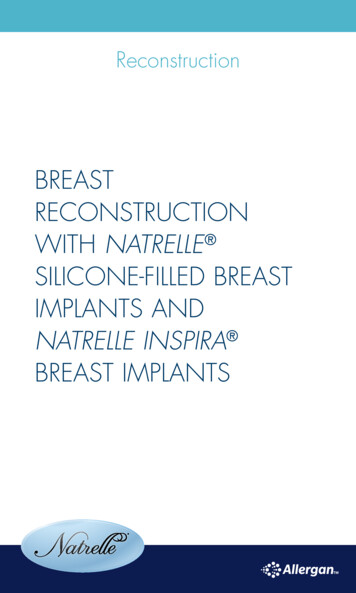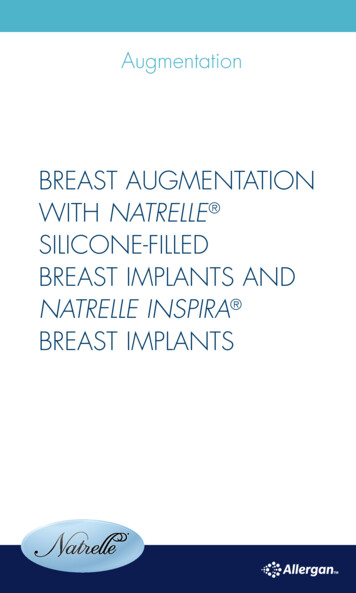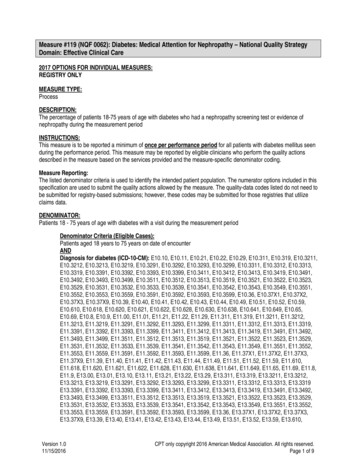
Transcription
Measure #112 (NQF 2372): Breast Cancer Screening – National Quality Strategy Domain: EffectiveClinical Care2016 PQRS OPTIONS FOR INDIVIDUAL MEASURES:CLAIMS, REGISTRYDESCRIPTION:Percentage of women 50 through 74 years of age who had a mammogram to screen for breast cancer within 27monthsINSTRUCTIONS:This measure is to be reported a minimum of once per reporting period for female patients seen during thereporting period. There is no diagnosis associated with this measure. The patient should either be screened forbreast cancer on the date of service OR there should be documentation that the patient was screened for breastcancer at least once within 27 months prior to the date of service. Performance for this measure is not limited to thereporting period. This measure may be reported by clinicians who perform the quality actions described in themeasure based on services provided and the measure-specific denominator coding.Measure Reporting via Claims:CPT or HCPCS codes and patient demographics are used to identify patients who are included in the measure’sdenominator. CPT Category II codes are used to report the numerator of the measure.When reporting the measure via claims, submit the listed CPT or HCPCS codes, and the appropriate CPT CategoryII code OR the CPT Category II code with the modifier. The modifiers allowed for this measure are: 1P- medicalreasons, 8P- reason not otherwise specified. All measure-specific coding should be reported on the claim(s)representing the eligible encounter.Measure Reporting via Registry:CPT or HCPCS codes and patient demographics are used to identify patients who are included in the measure’sdenominator. The listed numerator options are used to report the numerator of the measure.The quality-data codes listed do not need to be submitted for registry-based submissions; however, these codes maybe submitted for those registries that utilize claims data.DENOMINATOR:Women 50 through 74 years of age with a visit during the measurement periodDENOMINATOR NOTE: The measure's 27-month look back period applies to women ages 52-74 (thenumerator looks for a mammogram any time on or between October 1, 27 months prior to the measurementperiod, and December 31 of the measurement period in order to capture women who have had amammogram every 24 months per clinical guidelines, with a 3-month grace period). Therefore, women ages50-52 are included in the measure if they had a visit and a mammogram since age 50, but the 27-monthlook back period only applies to patients age 52-74. For patients that are 51 years of age during themeasurement period look back only to age 50.Denominator Criteria (Eligible Cases):Patients 50 through 74 years of age on date of encounterANDPatient encounter during the reporting period (CPT or HCPCS): 99201, 99202, 99203, 99204, 99205,99212, 99213, 99214, 99215, 99341, 99342, 99343, 99344, 99345, 99347, 99348, 99349, 99350, G0402,G0438, G0439Version 10.011/17/2015CPT only copyright 2015 American Medical Association. All rights reserved.Page 1 of 6
NUMERATOR:Patients with one or more mammograms any time on or between October 1, 27 months prior to December 31 of themeasurement period, not to precede the patient’s 50th birthdayORORNumerator Quality-Data Coding Options for Reporting Satisfactorily:Mammogram PerformedPerformance Met: CPT II 3014F:Screening mammography results documented andreviewedMammogram not Performed for Medical ReasonsAppend a modifier (1P) to CPT Category II code 3014F to report documented circumstances thatappropriately exclude patients from the denominator.Medical Performance Exclusion: 3014F with 1P: Documentation of medical reason(s) for not performinga mammogram (i.e., women who had a bilateralmastectomy or two unilateral mastectomies)Mammogram not Performed, Reason not Otherwise SpecifiedAppend a reporting modifier (8P) to CPT Category II code 3014F to report circumstances when the actiondescribed in the numerator is not performed and the reason is not otherwise specified.Performance Not Met: 3014F with 8P:Screening mammography results were not documentedand reviewed, reason not otherwise specifiedRATIONALE:Breast cancer is one of the most common types of cancers, accounting for a quarter of all new cancer diagnoses forwomen in the U.S. (BreastCancer.Org, 2011). It ranks as the second leading cause of cancer-related mortality inwomen, accounting for nearly 40,000 estimated deaths in 2013 (American Cancer Society, 2011).According to the National Cancer Institute’s Surveillance Epidemiology and End Results program, the chance of awoman being diagnosed with breast cancer in a given year increases with age. By age 30, it is one in 2,212. By age40, the chances increase to one in 235, by age 50, it becomes one in 54, and, by age 60, it is one in 25. From 2004to 2008, the median age at the time of breast cancer diagnosis was 61 years among adult women (Tangka et al,2010).In the U.S., costs associated with a diagnosis of breast cancer range from 451 to 2,520, factoring in continuedtesting, multiple office visits and varying procedures. The total costs related to breast cancer add up to nearly 7billion per year in the U.S., including 2 billion spent on late-stage treatment (Lavigne et al, 2008; Boykoff et al,2009).CLINICAL RECOMMENDATION STATEMENTS:The U.S. Preventive Services Task Force (USPSTF) recommends biennial screening mammography for womenaged 50-74 years (B recommendation). The decision to start regular, biennial screening mammography before theage of 50 years should be an individual one and take patient context into account, including the patient’s valuesregarding specific benefits and harms (C recommendation). (USPSTF, 2009) The Task Force concludes theevidence is insufficient to assess the additional benefits and harms of screening mammography in women 75 yearsand older (I statement).U.S. Preventive Services Task Force (2009)Grade: B recommendation. The USPSTF recommends biennial screening mammography for women aged 50 to 74years.Version 10.011/17/2015CPT only copyright 2015 American Medical Association. All rights reserved.Page 2 of 6
Grade: C recommendation. The decision to start regular, biennial screening mammography before the age of 50years should be an individual one and take patient context into account, including the patient’s values regardingspecific benefits and harms.Grade: I Statement. The USPSTF concludes that the current evidence is insufficient to assess the additional benefitsand harms of screening mammography in women 75 years or older.Grade: D recommendation. The USPSTF recommends against teaching breast self-examination (BSE).Grade: I Statement. The USPSTF concludes that the current evidence is insufficient to assess the additional benefitsand harms of clinical breast examination (CBE) beyond screening mammography in women 40 years or older.Grade: I Statement. The USPSTF concludes that the current evidence is insufficient to assess the additional benefitsand harms of either digital mammography or magnetic resonance imaging (MRI) instead of film mammography asscreening modalities for breast cancer.COPYRIGHT:These performance measures were developed and are owned by the National Committee for Quality Assurance("NCQA"). These performance measures are not clinical guidelines and do not establish a standard of medical care.NCQA makes no representations, warranties, or endorsement about the quality of any organization or physician thatuses or reports performance measures and NCQA has no liability to anyone who relies on such measures. NCQAholds a copyright in this measure and can rescind or alter this measure at any time. Users of the measure shall nothave the right to alter, enhance, or otherwise modify the measure and shall not disassemble, recompile, or reverseengineer the source code or object code relating to the measure. Anyone desiring to use or reproduce the measurewithout modification for a noncommercial purpose may do so without obtaining any approval from NCQA. Allcommercial uses must be approved by NCQA and are subject to a license at the discretion of NCQA. Use by healthcare providers in connection with their own practices is not commercial use. A "commercial use" refers to any sale,license, or distribution of a measure for commercial gain, or incorporation of a measure into any product or servicethat is sold, licensed, or distributed for commercial gain, even if there is no actual charge for inclusion of themeasure. 2004-2016 National Committee for Quality Assurance, all rights reserved.Performance measures developed by NCQA for CMS may look different from the measures solely created andowned by NCQA.CPT contained in the Measures specifications is copyright 2004-2015 American Medical Association.Version 10.011/17/2015CPT only copyright 2015 American Medical Association. All rights reserved.Page 3 of 6
Version 10.011/17/2015CPT only copyright 2015 American Medical Association. All rights reserved.Page 4 of 6
2016 Claims/Registry Individual Measure FlowPQRS #112 NQF# 2372: Breast Cancer ScreeningPlease refer to the specific section of the Measure Specification to identify the denominator and numeratorinformation for use in reporting this Individual Measure.1. Start with Denominator2. Check Patient Age:a. If Patient Age on Date of Service is 50 thru 74 years of age and equals No during the measurementperiod, do not include in Eligible Patient Population. Stop Processing.b. If Patient Age on Date of Service is 50 thru 74 years of age and equals Yes during the measurementperiod, proceed to check Encounter Performed.3. Check Encounter Performed:a. If Encounter as Listed in the Denominator equals No, do not include in Eligible Patient Population. StopProcessing.b. If Encounter as Listed in the Denominator equals Yes, include in the Eligible population.4. Denominator Population:a. Denominator population is all Eligible Patients in the denominator. Denominator is represented asDenominator in the Sample Calculation listed at the end of this document. Letter d equals 8 patients inthe sample calculation.5. Start Numerator6. Check Screening Mammography Results Documented and Reviewed:a. If Screening Mammography Results Documented and Reviewed equals Yes, include in Reporting Metand Performance Met.b. Reporting Met and Performance Met letter is represented in the Reporting Rate and Performance Rate inthe Sample Calculation listed at the end of this document. Letter a equals 3 patients in SampleCalculation.c. If Screening Mammography Results Documented and Reviewed equals No, proceed to DocumentedMedical Reason Mammogram Not Performed.7. Check Documented Medical Reason Mammogram Not Performed:a. If Documented Medical Reason Mammogram Not Performed equals Yes, include in Reporting Met andPerformance Exclusion.b. Reporting Met and Performance Exclusion letter is represented in the Reporting Rate and PerformanceRate in the Sample Calculation listed at the end of this document. Letter b equals 2 patients in theSample Calculation.c. If Documented Medical Reason Mammogram Not Performed equals No, proceed to ScreeningMammography Results were Not Documented and Reviewed, Reason Not Otherwise Specified.Version 10.011/17/2015CPT only copyright 2015 American Medical Association. All rights reserved.Page 5 of 6
8. Check Screening Mammography Results were Not Documented and Reviewed, Reason Not OtherwiseSpecified:a. If Screening Mammography Results were Not Documented and Reviewed, Reason Not OtherwiseSpecified equals Yes, include in the Reporting Met and Performance Not Met.b. Reporting Met and Performance Not Met letter is represented in the Reporting Rate in the SampleCalculation listed at the end of this document. Letter c equals 2 patients in the Sample Calculation.c. If Screening Mammography Results were Not Documented and Reviewed, Reason Not OtherwiseSpecified equals No, proceed to Reporting Not Met.9. Check Reporting Not Met:a. If Reporting Not Met equals No, Quality Data Code or equivalent not reported. 1 patient has beensubtracted from the reporting numerator in the sample calculation.Version 10.011/17/2015CPT only copyright 2015 American Medical Association. All rights reserved.Page 6 of 6
reporting period. This measure may be reported by clinicians who perform the quality actions described in the measure based on services provided and the measure-specific denominator coding. Measure Reporting via Claims: CPT or HCPCS codes and patient demographics are used to identify patients who are included in the measure's denominator.
